Prince Eitel Friedrich of Prussia
Prince Wilhelm Eitel Friedrich Christian Karl of Prussia (7 July 1883 – 8 December 1942) was the second son of Emperor Wilhelm II of Germany by his first wife, Princess Augusta Viktoria of Schleswig-Holstein-Sonderburg-Augustenburg. He was born and died in Potsdam, Germany.
| Prince Eitel Friedrich | |
|---|---|
.jpg.webp) Friedrich as captain of the First Regiment of Foot Guards, Potsdam | |
| Born | 7 July 1883 Marmorpalais, Potsdam, Prussia, German Empire |
| Died | 8 December 1942 (aged 59) Potsdam, Brandenburg, Nazi Germany |
| Burial | 12 December 1942 |
| Spouse | Duchess Sophia Charlotte of Oldenburg |
| House | Hohenzollern |
| Father | Wilhelm II, German Emperor |
| Mother | Augusta Victoria of Schleswig-Holstein |
| Religion | Lutheranism (Prussian United) |
| Prussian Royalty |
| House of Hohenzollern |
|---|
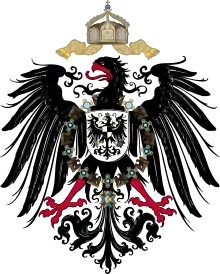 |
| Wilhelm II |
Life and activities
On 27 February 1906, Prince Eitel married Duchess Sophia Charlotte of Oldenburg (2 February 1879 Oldenburg – 29 March 1964 Westerstede) in Berlin. They were divorced on 20 October 1926 on the grounds of her adultery before the war. They had no children.
Raised at the cadet corps of Plön Castle, Prince Eitel was in the front line from the beginning of World War I and was wounded at Bapaume, where he commanded the Prussian First Foot Guards. He temporarily relinquished command to Count Hans von Blumenthal, but returned to duty before the end of the year. The following year, he was transferred to the Eastern Front. During the summer of 1915, he was out in a field in Russia when he had a chance encounter with Manfred von Richthofen, who had just crashed with his superior officer, Count Holck. The two men were hiding in a nearby tree line from what they thought was the advancing Russian army and who turned out to be the grenadiers, guardsmen, and officers of Prince Eitel.
After the war, he was engaged in monarchist circles and Der Stahlhelm ex-servicemens' organization. In 1921, the Berlin criminal court found him guilty of the fraudulent transfer of 300,000 Marks and sentenced him to a fine of 5000 Marks.[1]
From 1907 to 1926, he was Master of the Knights (Herrenmeister) of the Order of St. John (Johanniterorden). He received the Pour le Mérite order in 1915. His body is buried at the Antique Temple in Sanssouci Park, Potsdam.
Regimental Commissions[2]
- Hauptmann (captain) and commander of the Leibkompagnie (Life-company), 1. Garderegiment zu Fuß (1st Regiment of Foot Guards)
- à la suite, Grenadierregiment König Friedrich Wilhelm IV.(1. Pommersches) Nr. 2
- à la suite, 1. Gardelandwehrregiment (Guard Reserve Regiment)
- Hauptmann (captain), Austria-Hungary K.u.K. Infantry Regiment "Wilhelm I., Deutscher Kaiser und König von Preußen" Nr. 34
- Hauptmann (captain), Saxon Army
- à la suite, 7. Königsinfanterieregiment (King's Infantry Regiment) Nr. 106
- First Brigade of Imperial Guards, commander, 1914–15[3]
Orders and decorations
- German decorations[2]
.svg.png.webp) Prussia:
Prussia:
- 34th Master of Knights of the Johanniter Order, 1907–1926
- Founder of the Cross of the Mount of Olives, 24 December 1909
- Knight of the Black Eagle, with Collar
- Grand Cross of the Red Eagle, with Crown
- Knight of the Prussian Crown, 1st Class
- Grand Commander of the Royal House Order of Hohenzollern
- Iron Cross, 2nd and 1st Classes, 1914
- Pour le Mérite, 22 March 1915; with Oak Leaves, 14 May 1915
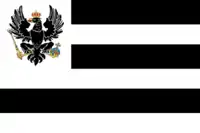 Hohenzollern: Cross of Honour of the Princely House Order of Hohenzollern, 1st Class with Swords
Hohenzollern: Cross of Honour of the Princely House Order of Hohenzollern, 1st Class with Swords.svg.png.webp) Baden:
Baden:
- Knight of the House Order of Fidelity, 1904[4]
- Commander of the Military Karl-Friedrich Merit Order
.svg.png.webp) Bavaria:
Bavaria:
- Knight of St. Hubert
- Officer of the Military Merit Order, with Swords
 Brunswick: War Merit Cross
Brunswick: War Merit Cross.svg.png.webp)
.svg.png.webp)
.svg.png.webp) Ernestine duchies:
Ernestine duchies:
- Grand Cross of the Saxe-Ernestine House Order, with Swords
- Cross for Merit in War (Saxe-Meiningen)
 Hamburg: Hanseatic Cross
Hamburg: Hanseatic Cross Mecklenburg:
Mecklenburg:
- Grand Cross of the Wendish Crown, with Crown in Ore
- Cross for Distinction in War, 1st Class (Strelitz)
 Oldenburg:
Oldenburg:
- Grand Cross of the Order of Duke Peter Friedrich Ludwig, with Golden Crown, Collar and Swords
- Friedrich August Cross, 1st Class
.svg.png.webp) Saxony:
Saxony:
- Knight of the Rue Crown
- Knight of the Military Order of St. Henry, 20 March 1915
 Württemberg: Grand Cross of the Württemberg Crown, 1899
Württemberg: Grand Cross of the Württemberg Crown, 1899
- Foreign decorations[5]
.svg.png.webp) Austria-Hungary: Grand Cross of St. Stephen, 1900[6]
Austria-Hungary: Grand Cross of St. Stephen, 1900[6]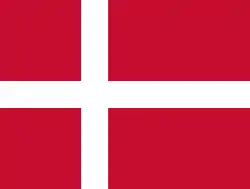 Denmark: Knight of the Elephant, 19 November 1906[7]
Denmark: Knight of the Elephant, 19 November 1906[7]_crowned.svg.png.webp) Kingdom of Italy: Knight of the Annunciation, 27 August 1902[8]
Kingdom of Italy: Knight of the Annunciation, 27 August 1902[8].svg.png.webp) Empire of Japan: Grand Cordon of the Order of the Chrysanthemum, 21 May 1908[9]
Empire of Japan: Grand Cordon of the Order of the Chrysanthemum, 21 May 1908[9] Netherlands: Grand Cross of the Netherlands Lion
Netherlands: Grand Cross of the Netherlands Lion Norway: Grand Cross of St. Olav, with Collar
Norway: Grand Cross of St. Olav, with Collar.svg.png.webp) Ottoman Empire:
Ottoman Empire:
- Order of Glory
- Order of Osmanieh, 1st Class in Diamonds
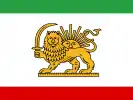 Persian Empire: Order of the Lion and the Sun, 1st Class
Persian Empire: Order of the Lion and the Sun, 1st Class.svg.png.webp) Kingdom of Portugal: Grand Cross of the Tower and Sword
Kingdom of Portugal: Grand Cross of the Tower and Sword.svg.png.webp) Qing dynasty: Order of the Double Dragon, Class I Grade II
Qing dynasty: Order of the Double Dragon, Class I Grade II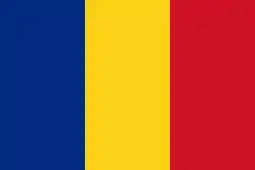 Kingdom of Romania: Grand Cross of the Crown of Romania
Kingdom of Romania: Grand Cross of the Crown of Romania.svg.png.webp) Siam:
Siam:
- Knight of the Order of the Royal House of Chakri, 6 June 1902[10]
- Grand Cross of the Crown of Siam
.svg.png.webp) Sweden: Knight of the Seraphim, 1 December 1904[11]
Sweden: Knight of the Seraphim, 1 December 1904[11] United Kingdom: Honorary Grand Cross of the Royal Victorian Order, 1 July 1904[12] (expelled in 1915)
United Kingdom: Honorary Grand Cross of the Royal Victorian Order, 1 July 1904[12] (expelled in 1915)
- Honours
Two ships were named after Prince Eitel, the passenger ship Prince Eitel Friedrich (1901) and the Reich postal steamer Prince Eitel Friedrich (1904).
Ancestry
| Ancestors of Prince Eitel Friedrich of Prussia |
|---|
References
- Tucholsky: Awrumele Schabbesdeckel und Prinz Eitel-Friedrich von Hohenzollern at www.textlog.de
- Handbuch über den Königlich Preußischen Hof und Staat (1918), Genealogy p.1
- The American Library Annual. R.R. Bowker Co. 1915. p. 25.
- Hof- und Staats-Handbuch des Großherzogtum Baden (1910), "Großherzogliche Orden" p. 41
- Hof- und Staats-Handbuch des Königreich Preußen (1908), Genealogy p.1
- "A Szent István Rend tagjai" Archived 22 December 2010 at the Wayback Machine
- Jørgen Pedersen (2009). Riddere af Elefantordenen, 1559–2009 (in Danish). Syddansk Universitetsforlag. p. 468. ISBN 978-87-7674-434-2.
- Italy. Ministero dell'interno (1920). Calendario generale del regno d'Italia. p. 57.
- 刑部芳則 (2017). 明治時代の勲章外交儀礼 (PDF) (in Japanese). 明治聖徳記念学会紀要. p. 150.
- Royal Thai Government Gazette (6 June 1902). "ส่งเครื่องราชอิสริยาภรณ์ไปพระราชทานเจ้าต่างประเทศ" (PDF) (in Thai). Retrieved 2019-05-08. Cite journal requires
|journal=(help) - Sveriges statskalender (in Swedish), 1905, p. 441, retrieved 2018-01-06 – via runeberg.org
- Shaw, Wm. A. (1906) The Knights of England, I, London, p. 430
Sources
Schench, G. Handbuch über den Königlich Preuβischen Hof und Staat fur das Jahr 1908. Berlin, Prussia, 1907.
Prince Eitel Friedrich of Prussia Born: 7 July 1883 Died: 8 December 1942 | ||
| Preceded by Albrecht, Prinz von Preußen |
Herrenmeister (Grand Master) of the Order of Saint John 1907–1926 |
Succeeded by Oskar, Prinz von Preußen |
|}